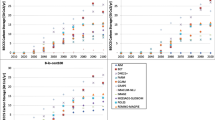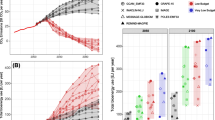Abstract
The United Nations Framework Convention on Climate Change (UNFCCC 1992) calls for stabilization of atmospheric greenhouse gas (GHG) concentrations at a level that would prevent dangerous anthropogenic interference with the climate system. We use three global energy system models to investigate the technological and economic attainability of meeting CO2 concentration targets below current levels. Our scenario studies reveal that while energy portfolios from a broad range of energy technologies are needed to attain low concentrations, negative emission technologies—e.g., biomass energy with carbon capture and storage (BECCS)—significantly enhances the possibility to meet low concentration targets (at around 350 ppm CO2).
Similar content being viewed by others
References
Azar C, Rodhe H (1997) Targets for stabilization of atmospheric CO2. Science 276:1818–1819
Azar C, Schneider SH (2002) Are the economic costs of stabilizing the atmosphere prohibitive? Ecol Econ 42:73–80
Azar C, Lindgren K, Andersson B (2003) Global energy scenarios meeting stringent CO2 constraints—cost effective fuel choices in the transportation sector. Energy Policy 31:961–976
Azar C, Lindgren K, Larson E, Möllersten K (2006) Carbon capture and storage from fossil fuels and biomass—costs and potential role in stabilizing the atmosphere. Clim Change 74:47–79
Berndes G, Hoogwijk M, Van den Broek R (2003) The contribution of biomass in the future global energy supply: a review of 17 studies. Biomass Bioenergy 25:1–28
Bouwman AF, Kram T, Klein Goldewijk K (2006) Integrated modelling of global environmental change. Netherlands Environmental Assessment Agency (MNP), Bilthoven, October 2006. Available at http://www.rivm.nl/bibliotheek/rapporten/500110002.pdf
De Vries HJM, Van Vuuren DP, Den Elzen MGJ, Janssen MA (2002) The targets image energy model regional (TIMER)—Technical documentation. National Institute of Public Health and the Environment (RIVM), Bilthoven, the Netherlands
European Council (2005) Presidency conclusion; 7619/1/05, REV 1, 22nd–23rd March 2005; http://ue.eu.int/ueDocs/cms_Data/docs/pressData/en/ec/84335.pdf
Fisher B, Nakicenovic N, Alfsen K, Corfee Morlot J, de la Chesnaye F, Hourcade J-C, Jiang K, Kainuma M, La Rovere E, Matysek A, Rana A, Riahi K, Richels R, Rose S, Van Vuuren D, Warren R, Ambrosi P, Birol F, Bouille D, Clapp C, Eickhout B, Hanaoka T, Mastrandrea MD, Matsuoko Y, O’Neill B, Pitcher H, Rao S, Toth F (2007) Issues related to mitigation in the long-term context. In: Metz B, Davidson O, Bosch P, Dave R, Meyer L (eds) Climate change 2007. Mitigation of climate change. Contribution of Working Group III to the Fourth Assessment Report of the Intergovernmental Panel on Climate Change. Cambridge University Press, New York, pp 169–250
Graßl H, Kokott J, Kulessa M, Luther J, Nuscheler F, Sauerborn R, Schellnhuber H-J, Schubert R, Schulze E-D (2003) Climate protection strategies for the 21st century: Kyoto and beyond. Report prepared by the German Advisory Council on Global Change (WBGU), Berlin, Germany
Hansen JE (2005) A slippery slope: how much global warming constitutes dangerous anthropogenic interference. Clim Change 68:269–279
Hoffert MI, Caldeira K, Benford G, Criswell DR, Green C, Herzog H, Jain AK, Kheshgi HS, Lackner KS, Lewis JS, Lightfoot HD, Manheimer W, Mankins JC, Mauel ME, Perkins LJ, Schlesinger ME, Volk T, Wigley TML (2002) Advanced technology paths to global climate stability: energy for a greenhouse planet. Science 298:981–987
IPCC (2005) Special report on CO2 capture and storage. Cambridge University Press, Cambridge
Keith D (2009) Why capture CO2 from the atmosphere. Science 325:1654–1655
Knopf B, Edenhofer O, Barker T, Baumstark L, Criqui P, Held A, Isaac M, Jakob M, Jochem E, Kitous A, Kypreos S, Leimbach M, Magné B, Mima S, Schade W, Scrieciu S, Turton H, van Vuuren DP (2009) The economics of low stabilisation: implications for technological change and policy. In: Hulme M, Neufeld H (eds) Making climate work for us
Leemans R, van Amstel A, Battjes C, Kreileman E, Toet S (1996) The land cover and carbon cycle consequences of large-scale utilizations of biomass as an energy source. Glob Environ Change 6(4):335–357
Lenton TM, Held H, Kriegler E, Hall JW, Lucht W, Rahmstorf S, Schellnhuber HJ (2008) Tipping elements in the Earth’s climate system. Proc Natl Acad Sci U S A 105:1786–1793
MEF (2009) Declaration on energy and climate. Major Economies Forum, L’Aquila, Italy
Meinshausen M, Hare B, Wigley TML, van Vuuren DP, den Elzen MGJ, Swart R (2006) Multi-gas emission pathways to meet arbitrary climate targets. Clim Change 75:151–194
Nakicenovic N, Swart R (eds) (2000) Special report on emissions scenarios. Cambridge University Press, Cambridge, ISBN 0521804930, pp 612
O’Neill BC, Oppenheimer M (2004) Climate change impacts are sensitive to the concentration stabilization path. PNAS 101:16411–16416
Obersteiner M, Azar Ch, Kauppi P, Möllersten K, Moreira J, Nilsson S, Read P, Riahi K, Schlamadinger B, Yamagata Y, Yan J, van Ypersele J-P (2001) Managing climate risk. Science 294(5543):786–787
Pacala S, Socolow R (2004) Stabilization wedges: solving the climate problem for the next 50 years with current technologies. Science 305:968–972
Persson UM, Azar C (2010) Preserving the world’s tropical forests: a price on carbon may not do. Environ Sci Technol 44:210–215
Rao S, Riahi K (2006) The role of non-CO2 greenhouse gases in climate change mitigation: long-term scenarios for the 21st century. Energy J 27:177–200
Riahi K, Grubler A, Nakicenovic N (2007) Scenarios of long-term socio-economic and environmental development under climate stabilization. Technol Forecast Soc Change 74:887–935
Rockström J, Steffen W, Noone K, Persson Ã, Chapin FS, Lambin EF, Lenton TM, Scheffer M, Folke C, Schellnhuber HJ, Nykvist B, De Wit CA, Hughes T, Van Der Leeuw S, Rodhe H, Sörlin S, Snyder PK, Costanza R, Svedin U, Falkenmark M, Karlberg L, Corell RW, Fabry VJ, Hansen J, Walker B, Liverman D, Richardson K, Crutzen P, Foley JA (2009) A safe operating space for humanity. Nature 461:472–475
Sandén B, Azar C (2005) Near term technology policies for long term climate targets. Energy Policy 33:1557–1576
Schrattenholzer L, Miketa A, Riahi K, Roehrl RA, Strubegger M (2004) Achieving a sustainable global energy system. Edward Elgar Publishing, Cheltenham
Searchinger T, Heimlich R, Houghton RA, Dong F, Elobeid A, Fabiosa J, Tokgoz S, Hayes D, Tun-Hsiang Y (2008) Use ofU.S. croplands for biofuels increases greenhouse gases through emissions from land-use change. Science 319(5867):1238–1240
Tilman D et al (2009) Beneficial biofuels—the food energy environment trilemma. Science 325:270–271
UNFCCC (1992) United Nations framework convention on climate change. http://www.unfccc.int/resources
van Vuuren DP, Den Elzen MGJ, Lucas P, Eickhout BE, Strengers BJ, Van Ruijven B, Wonink S, Van Houdt R (2007) Stabilizing greenhouse gas concentrations at low levels: an assessment of reduction strategies and costs. Clim Change 81:119–159
van Vuuren DP, van Vliet J, Stehfest E (2009) Future bio-energy potential under various natural constraints. Energy Policy 37:4220–4230
Wigley TML, Richels R, Edmonds J (1996) Economics and environmental choices in the stabilization of atmospheric CO2 concentrations. Nature 379:240–243
Author information
Authors and Affiliations
Corresponding author
Rights and permissions
About this article
Cite this article
Azar, C., Lindgren, K., Obersteiner, M. et al. The feasibility of low CO2 concentration targets and the role of bio-energy with carbon capture and storage (BECCS). Climatic Change 100, 195–202 (2010). https://doi.org/10.1007/s10584-010-9832-7
Received:
Accepted:
Published:
Issue Date:
DOI: https://doi.org/10.1007/s10584-010-9832-7




